ATHENS – MORE THAN JUST THE PARTHENON
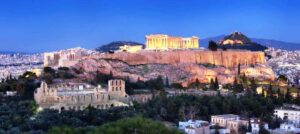
When we think of Athens, the first thing that usually comes to mind is the Parthenon, perched high on the Acropolis overlooking the city spread out below. As the Eiffel Tower is to Paris, similarly, the Parthenon is surely the symbol of Athens. As splendid, and totally unforgettable, as it is, there are some other outstanding sights to visit if you’ve got a spare day or two. Here are a couple of our favourites that are always on our list to visit each time we return to Athens—as well as a little retail therapy!

First on the list must surely be the Acropolis Museum, at the foot of the hill. The current building has been the city’s main archaeological museum since 2009, replacing the original that was constructed in 1865 right up on the Acropolis itself on the eastern edge of the rock. The volume of treasures kept increasing over the years as excavations unearthed more and more artefacts, but the site limited the size of the museum. Acknowledging this reality, the Greek government decided in the late 1980s to build a new, larger museum, at the foot of the Acropolis. After a couple of false starts, mostly relating to the location of the proposed site, a former barracks of the Hellenic Gendarmerie—the military police.
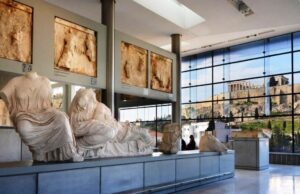
Another motivation for the construction of a new museum was the not entirely unjustified claim by the British Museum that they couldn’t possibly return the Parthenon Marbles—still also known as the Elgin Marbles—since the Greeks had nowhere to display them. The Brits also hinted that, in their view, they were much better placed to properly conserve and care for the sculptures than the Greeks. Such claims were spurious, and didn’t fool anyone that it merely disguised the fact that the Brits had no intention of returning the marbles, citing UK law, the British Museum Act of 1963, which prohibits the permanent deaccession (return) of objects from its collection, and furthermore, that the marbles were legally acquired—a somewhat spurious claim, given that the ruling Ottoman Empire gave permission to Lord Elgin to remove them. Additionally, the British Government and the museum officials maintain that the sculptures are part of a global collection, and that returning them is legally impossible.
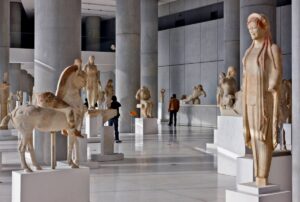
The old Acropolis Museum closed in June 2007 so that its contents could be moved to the new one, which opened on 20 June 2009. The new museum is such a contrast to the cramped, badly lit, rather gloomy and somewhat uninspiring space of the old one. The new museum is spacious, bright, filled with light, and a joy to experience. It’s only 280m away from the Parthenon, and 400m walking distance from it. It’s easy to get to, either walking through the Plaka, or via Akropoli station on the red line of the Athens Metro, directly opposite the museum.
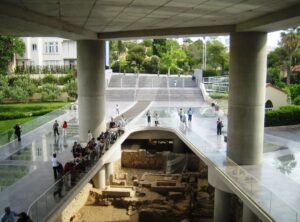
Leading to the museum’s main entrance much of the pathway is toughened glass, as well as an open void, where you can view the extensive archaeological site which forms part of the museum’s basement. This is beautifully done, and sets atmosphere for a visit inside.
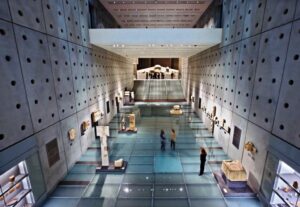
The museum’s collections are exhibited on 3 levels, while the 4th level has the museum shop, a good café with outdoor terrace, and the museum’s offices. The ground floor displays the findings of the slopes of the Acropolis, depicting the religious and public aspects of the daily life of ancient Athenians, such as offerings to the gods, ancient pottery, reliefs and figurines. The floor of this level slopes, to resemble the ascent up to the rock. On the 1st floor is a large hall that shows the Archaic findings.
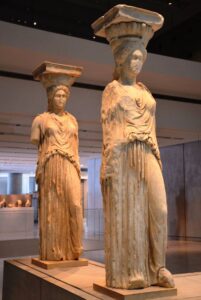
Also on the same floor there are artefacts and sculptures from the other Acropolis buildings, such as Caryatids from the Erechtheum (those on site now are reproductions), the Temple of Athena Nike and the Propylaea monumental gateway. There are also findings from Roman and early Christian Athens, and the idea is to visit these last, in order to keep the chronological order.
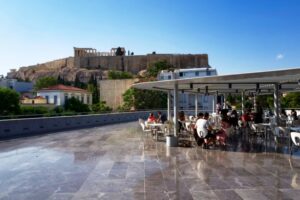
We believe that it’s essential to visit the Museum before heading up to the Acropolis. When you finally get there and start exploring, a visit to the museum beforehand puts the whole site in context and makes a visit so much more meaningful and enjoyable.
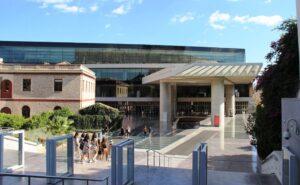 Consider purchasing a Combo Acropolis Parthenon + Acropolis Museum Pass online in advance of your visit. This costs around 65 Euros, so not cheap, but the mere fact of skipping the very long queues for both these attractions makes the purchase well worthwhile for the visitor with limited time. The price also includes an audio guide at both sites, and an option for either a set entry time or skip-the-line.
Consider purchasing a Combo Acropolis Parthenon + Acropolis Museum Pass online in advance of your visit. This costs around 65 Euros, so not cheap, but the mere fact of skipping the very long queues for both these attractions makes the purchase well worthwhile for the visitor with limited time. The price also includes an audio guide at both sites, and an option for either a set entry time or skip-the-line.
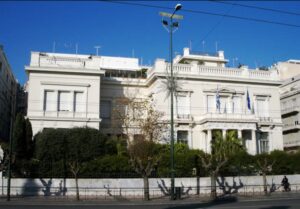
Another great museum that’s always on our list to visit is the Benaki Museum. Located at no. 1 Koumpari, on the corner of Queen Sofias Avenue, it’s across the road from the National Botanical Gardens, which is part of the Syntagma gardens and Hellenic Parliament complex. Established in 1930 by Antonis Benakis in memory of his father Emmanuel, the museum is housed in the beautiful Benakis family mansion, built in 1860.

The collections contain Greek artworks from the prehistoric to the modern era, an extensive collection of Asian art and hosts temporary exhibitions, as well as maintaining a highly regarded art restoration and conservation workshop. The museum originally housed a collection that included Islamic art, Chinese porcelain and exhibits on toys, but after it re-opened in 2000 following restoration after an earthquake, a number of satellite museums were established to focus on specific collections, allowing the main museum to focus on Greek culture over the span of the country’s history.
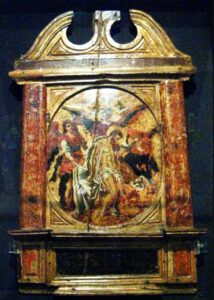
The museum now houses over 100,000 artefacts from Greek history, and also showcases the many civilisations and cultures which have influenced the development of Greece.

For us, one of the most interesting exhibitions in the Benaki is on the top floor. This floor is devoted to the subject of Greek independence and the related struggles, covering the 19th and 20th centuries. There are paintings telling the stories of tumultuous events and the personalities identified with them, such as the well-known portrait of Lord Byron dressed in the costume associated with the Greek independence movement of 1821. This is the only museum we’ve come across that doesn’t only deal with Greece’s ancient history, but its fascinating recent past. Spread over a number of locations, the museum ranks among Greece’s foremost cultural institutions.
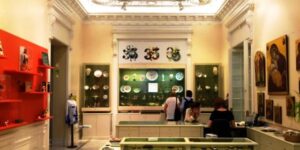
The size of the Benaki means it’s perfect for those with limited time but who are interested in a very good overview of fine, historic Greek cultural treasures. There is a very nice café in the museum with a delightful outdoor terrace. The museum shop sells high quality replicas of a number of items from the collection ranging from ceramics to busts of Greek gods and statuary, silver cups, jugs, Byzantine icons and fine jewellery. Note: the museum is closed on Tuesdays.
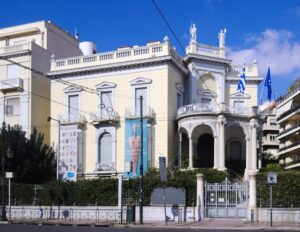
Barely 3 mins. walk from the Benaki Museum, and 10 mins. from Syntagma Square, is one of my personal favourites: the Museum of Cycladic Art, located at 4 Neophytu Douka St. The museum’s main building was erected in in 1985, but in 1991, the museum acquired a magnificent mansion built for the wealthy Stathatos family in 1895 on the corner of Vassilissis Sofias Ave. and Herodotou St.

The museum’s permanent collection includes over 3,000 items, and has been described as one of the world’s most significant privately assembled collections of Cycladic antiquities. There are marble figurines, vases made of marble and clay, and bronze tools dating from the 3rd millennium BCE. The collection traces a journey through time focusing on the socio-political developments, such as the rise of Minoan Crete and Mycenean Greece, the birth of the ancient city, the emergence of democracy and the creation of the first Mediterranean empires.
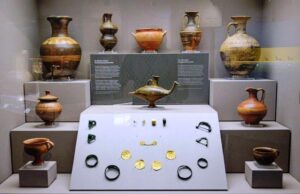
The artefacts tell the story of an island civilization that combined Aegean, Egyptian and Near Eastern influences in its artistic expression. There are objects that tell of everyday life in a city of Classical times, combined with explanatory texts, audiovisual presentations and 3D illustrations. The exhibits illustrate an ancient culture who carved, worshipped, hunted, feasted and gazed at the starry sky of the Aegean.
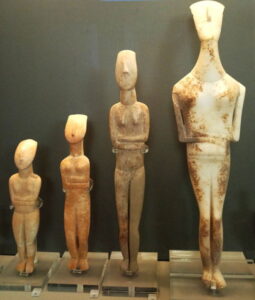
Looking at ancient Cycladic sculptures in the museum, it’s easy to see how this art influenced the aesthetics of 20th and 21st century artists—think Picasso, Modigliani among others. As you’d expect, the museum has a very good shop. There’s also a nice café in house. The museum is closed on Tuesdays.

After visiting these and other cultural sites, it’s time for a change of scene and a little light relief. If some retail therapy springs to mind, Athens has lots to offer. Needless to say, there are a number of shopping areas in a city as big as Athens, but for the visitor, who is likely going to spend much of their time in and around the Acropolis, its museum and the other two mentioned above, locations within easy walking distance of these are what I will concentrate on here.
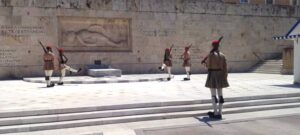
One of the best shopping areas is immediately off Syntagma Square. This is located straight in front of the gardens of Syntagma Square, which are directly in front of the Monument of the Unknown Soldier in front of the Hellenic Parliament building where you can watch the changing of the guard that takes place on the hour, every day—the guards wear traditional Greek costumes, complete with the short, pleated skirts, making the ceremony a perfect photo opportunity. Note that there is a more formal parade on Sundays at 11.00am, complete with military band. There is also a handy metro station in the Syntagma Square gardens.
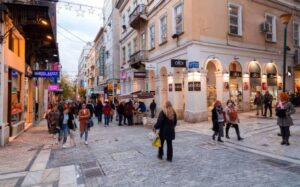
Ermou Street is a major pedestrian shopping street that runs from Syntagma Square down to Monastiraki and beyond. We’ve always referred to this street as Shoe Shop Street, due to the great number of shoe shops selling styles ranging from inexpensive sandals for beach and casual wear, right through to highly embellished, dressy shoes perfect for a big night out, formal occasions, weddings and such-like. The shoes are almost all made in Greece and are generally good quality and good value, comparing very well to well-known international brands—which can also be found around Athens.
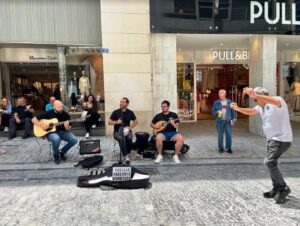
The street also has international fashion brands such as Zara, H&M and even a small branch of Marks & Spencer, located on the left-hand side of the street walking down from the Syntagma end. The street is always abuzz with a lively atmosphere due to frequent street performers such as musicians and other entertainers. You can also find a wide range of eating options, as well as street food vendors selling souvlaki, tiropita and roasted chestnuts.
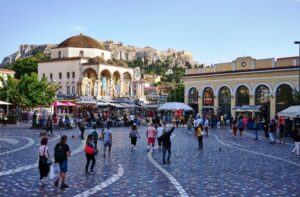
Ref. Monastiraki, if you’re in Athens on a Sunday, head to this neighbourhood to browse the biggest flea market in Athens. You will find all sorts of souvenirs, some good quality collectors’ items such as books, antiques and silverware, as well as footwear, leather bags and sandals, and beaded necklaces made by local artisans.
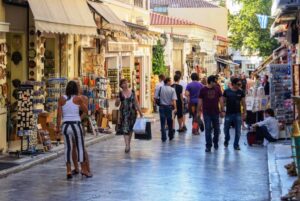
Towards the end of Ermou Street turn left at one of the side streets a couple of blocks after Marks & Spencer and you will come to the other main street in this district, Mitropoleos St. Walk up this street towards Syntagma and a block before that are a couple of little streets off to the right that wind up the hill to the Plaka and ultimately, the Acropolis. The Plaka is full of touristy souvenir shops and cheap ‘n cheerful cafes that are very good value and especially popular in the evenings.
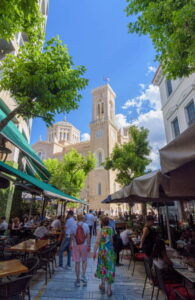
Mitropoleos Street is lined with pleasant tavernas, bars and restaurants, all serving traditional and more modern versions of Greek cuisine as well as the usual international array of pastas, pizzas etc., and it’s something of a surprise to come across one or two Asian restaurants—a sight one would not have seen in Greece up until to the last few years.
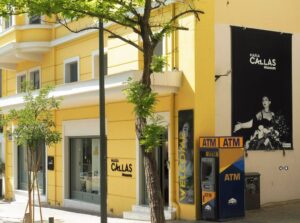
One building at no. 44 that music, and particularly opera-lovers, will be interested in visiting is the Maria Callas Museum, dedicated to the life and career of this great opera legend. The Municipality of Athens bought this 3 storey neoclassical building, previously the Royal Hotel, and the Maria Callas Museum opened in October 2023. The museum includes numerous personal objects owned by Callas, as well as operatic costumes and haute couture fashions. According to the museum’s director, and museologist, the exhibits were designed around Callas’ personality and include her singing voice and interviews.

Aside from Ermou and Mitropoleos Streets, there are a number of interesting shopping streets just behind the Benaki and Cycladic Museums, such as Panagiotou Anagnostopoulou and Skoufa Streets, then over towards Patriachou Ioakim Street and the Kolonaki area with its upscale and luxury boutiques. Some of the streets are lined with leafy trees making for a most pleasant, relaxing stroll browsing the small, individual shops, larger international names, high quality, modern jewellers, and a sprinkling of small, commercial art galleries.

Greece has some of the best resort wear anywhere, and most things tend to be made of cotton and linen or blends of these two. Perfect for hot days and warm evenings. A favourite Greek fashion label of ours is Parthenis, for both men and women, which has a boutique at 20, Dimokritou St., a few blocks behind the Cycladic Museum. Although having said that, we tend to shop at one of their other shops, on Mykonos, where we first discovered it. Ask your hotel reception desk people to mark these streets on your map. None is hard to find.
Athens has so many wonderful historic treasures, enough to fill a week or more, and in order not to suffer from cultural overload, it’s good to balance all that with some simple retail pleasures. Athens has it all.
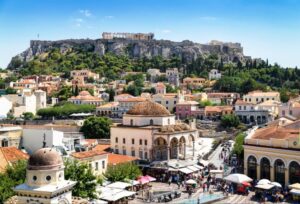


Leave a Reply